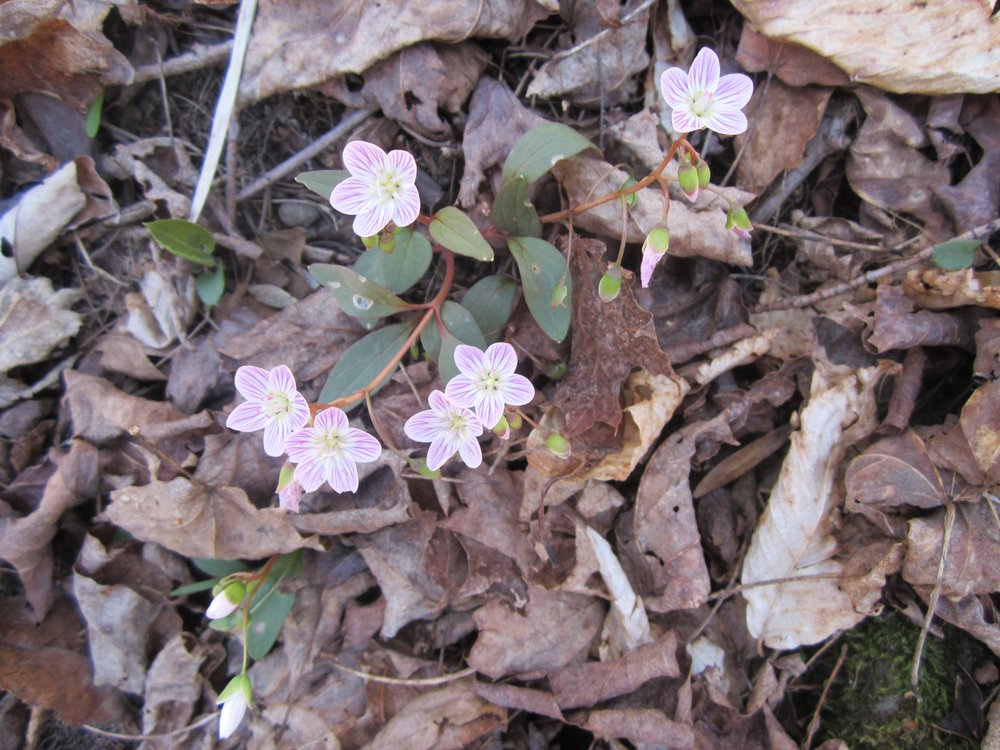Perfect Timing

Garbage CrewIt takes a while before we start to see the garbage. A bottle here or there rests at the edges of the still-brown cattails and phragmites that line the waterway that meanders through the North Tivoli Bay. When I pull the canoe up onto the mucky embankment Susan Lyne gets out and from her standing perspective locates a half dozen more items that don’t belong, items made of plastic or Styrofoam,glass, metal. She scoops them up, along with a plastic turkey, and we jam everything into two bags, one in front of her son, Emmet, the other behind him. Emmet is our youngest garbage collector and while he showed a real talent on land, grabbing things with the garbage picker, he’s less excited about being in the canoe. “It’s dirty,” he explains.
Susan with treasures from the Bay
It’s hard to find a kid—a boy—who doesn’t like mud. But he’s right. The mud is dirty. Besides the fact that it is gooey and brown it smells slightly, that fermented pond smell that makes me so happy. But who knows what else is laced into that mud? If I thought too much about that, I wouldn’t get out of my boat. So the truth is, I’m happy Emmet is a young neat-freak and keeping his hands and feet inside of the wide metal canoe.
The sun beats down on us as we gather more things. We watch as Sheri takes on an enormous plastic tarp and drags it behind her kayak. Emily has a bag stuffed into the cockpit of her kayak. The Bland family—Avis, Celia and Alex—have scooped up a refrigerator. It’s hard to tell who has the best booty.

We are all cruising the North Bay on a Saturday late morning in search of garbage. It’s a great treasure hunt And the more we find, the more we find. It works like that. Our eyes adjust so that a glint is a bottle, a bump the edge of a barrel. There’s a general sense of excitement and an extreme sense that we are doing good work. Knowing that in the South Tivoli Bay, a group of Bard College students are cruising those waters Bard College students, gleefulcollecting their own garbage adds to the collective sense of purpose. And in a few weeks, with Riverkeeper's River Sweep, groups the length of the river will clean up. We will make this Hudson River cleaner. One small thing in a world that needs lots of small things.
Soon enough, Emmet doesn’t want to be on the water any longer. I’m impressed he made it as far as he did, but I’m sorry to lose my canoe partners. Just then, my phone rings and my friend Georganna calls to say she’s a half hour away. Perfect timing.
I drop off one set of partners and all of our loot and scoop up the next. That George is still fresh helps to give me some energy. We work our way around the circuitous water paths of the north bay, until we reach the wide bay by the railroad underpass. Everyone seems to have vanished, though I know Emily and Sheri are out here somewhere. We poke along, past the docks that washed into the bay after Hurricane Irene. Then we meander down one of the alleyways that run parallel to the train tracks.
I glance over my shoulder and see a plant I have never seen before. “What’s that?” George asks as I’m about to exclaim, “Golden Club.”
Golden clubThough I’ve never seen this plant before it is so distinct I know right away what it is. Brilliant yellow prongs, like a riding crop, emerge from green leaves. It’s a plant I have been looking forfor years.
I first read about Golden Club in Ester Kiviat’s book about the Tivoli Bays. She goes in search of this rare flower, with no luck. Her quest sent me on my own searches and every year I have come up empty.
What surprises me is how beautiful the yellows are in this flower. Practically neon in their brightness. I jump out of the canoe to take photographs of the flower. I’m dizzy with excitement. A golden club at last. And what are the chances? It’s a flower that blooms but a week every year—usually in May. Here it is, early in the season, and without searching, I found it. Perfect timing.
Georganna with a canoe-load of garbage
Before I get back in the boat, I pick up a hunk of Styrofoam and a can of soda, dented and filled with mud.
Beautiful, Until it is Not
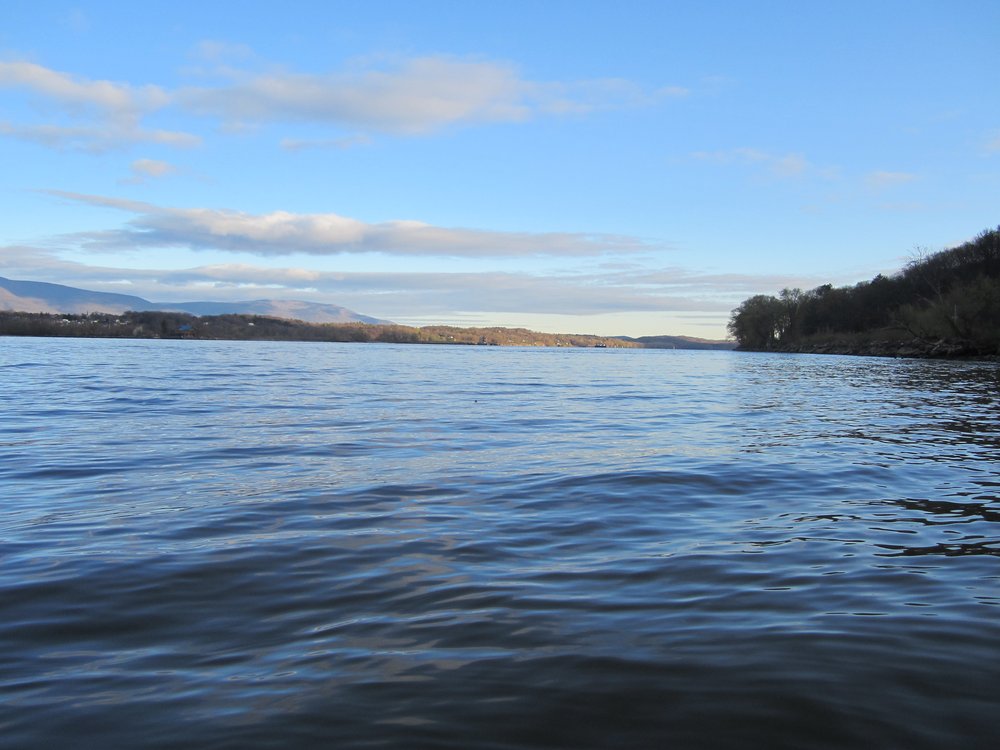
It would seem that staying out of the way of a big boat would be easy. They take up a lot of room; they are visible. But it is not that simple. This morning as I slipped my boat into the water at the Tivoli landing, the water was lightly feathered. At 41 degrees, I urged the sun and its promised warmth as it peaked over the eastern shoreline. A faint rumble emerged from the north. I scanned the river and saw nothing. But the noise wasn’t going away. It had to be a boat. I looked more closely. There, on the horizon, was a double barge, pushed by a tug. It was enormous. And it was almost invisible, thanks to my angle, the angle of the sun, the height of the barge. It all worked against me. I hugged the shore until it chugged past, then I made a dash for the western shore.

It would seem that staying out of the way of a big boat would be easy. They take up a lot of room; they are visible. But it is not that simple. This morning as I slipped my boat into the water at the Tivoli landing, the water was lightly feathered. At 41 degrees, I urged the sun and its promised warmth as it peaked over the eastern shoreline. A faint rumble emerged from the north. I scanned the river and saw nothing. But the noise wasn’t going away. It had to be a boat. I looked more closely. There, on the horizon, was a double barge, pushed by a tug. It was enormous. And it was almost invisible, thanks to my angle, the angle of the sun, the height of the barge. It all worked against me. I hugged the shore until it chugged past, then I made a dash for the western shore.

I looped back across the river cutting across the rocky prow of Magdalen Island. The North Bay sucked me in. A calm draped my shoulders, as I pushed back in my seat, my feet still a bit damp and cool from getting into my boat. The energy of the big river left me as I drifted with the incoming tide. I put my binoculars to my eyes and scanned the mudflats, exposed at low tide. I landed on the foraging movement two compact shorebirds, which I realized were Common Snipe. Why are they called Common? There is nothing common about a Snipe. Their long bills dwarf their pint sized bodies. And it’s a rare event to see one so clearly, the streaked back and short legs. Usually they skulk in tall grasses and take flight in a blur. Just as these two did, wheeling into the air.
I stroked into the bay, Common Mergansers taking flight in objection to my presence. Again: why Common? They are big ducks, with those great white bodies, tufted heads, long bills. Yes, common in that they are present, and so perhaps not so special to see. But once seen, they are remarkable birds. Perhaps we should get rid of “Common” attached to any bird. I count fifteen “Common” birds including the Common Murre, Common Pauraque, and Common Poorwill, three birds I have never seen. Let’s change them to Special. The Special Raven and the Special Grackle, like the ones feeding like crazy at my feeder this morning.

The bay before the railroad tracks let me know I was in for a ride. Wavelets formed, ruffling what is almost always a placid body of water. The wind of last night had awakened, and I could see the trees on Magdalen Island bending in the breeze. How fast the river changes. What had been a gentle morning was now a windy challenge.
I steeled myself for getting under the railroad bridge, bracing my legs and shoveling the water with determination. Once on the river the wind hit me. It took my boat broadside and pushed me south before I came around and pointed my nose north. My hands, which had been cold, now were really cold. My body was cold. I stroked into the wind, the waves sloshing over my boat.
I like wind. But I don’t like wind when I am cold, when the water is cold, when the wind is moving one way and the current another, forming frothy white caps. The wind made this big river appear enormous. I thought: I am not going to make it home.
It’s a sad thought to have.
I then did the unthinkable: I rode my boat onto the rocky shoreline. I pulled it out of the water, and above the high water mark. And I walked back to my car. It was the coldest, longest mile-long walk of my life. Leaving my boat felt a kind of betrayal. As I walked, I went through all of my options. I would drive home and pick up the wheels to attach to the back of my boat and wheel the boat back to my car. No. I’d drive down the rocky path beside the tracks (no doubt illegal), then walk on shore and float the kayak north. No. I’d drive down the tracks as far as possible then paddle the boat to that point. No. I could see there was no getting back in my boat.
What I did. I drove down the side of the tracks, where people in pick up trucks drive out to fish, drink or make out at the abandoned stone dock to Sycamore Point. I gave thanks to Subaru as the gravel spit beneath my tires. I kept on past the dock, the gravel less packed down, the passage narrower, until a large log blocked my way.
I jogged the 200 yards--which felt like 2 miles--to my boat, relieved when I saw its pink body resting on the gravel.
My boat weighs 46 pounds. This means I can carry it from my car to the water, and that I have a system to get it on the roof of my car. 46 pounds is not bad, until you have to carry it several hundred yards. Because the 46 pounds are spread out over sixteen and a half feet, it is an awkward 46 pounds. I hoisted the boat on my shoulder and looked forward. I wished I could see my car, which I had tucked to the side in the bushes that line the river, in case a train swooshed past. I could feel my shoulder begin to sag. The wind grabbed the boat and swung it away from my body. I staggered a bit, caught my foot on a rock. What are you doing out here? I hefted the boat more securely on my shoulder, and marched on. Keeping moving, I told myself. My hands were freezing. Don’t stop. My shoulder ached. Don’t put the boat down. I knew if I put it down, I wouldn’t pick it up again. Just keep walking, keep walking.
From Snow to Spring Beauties
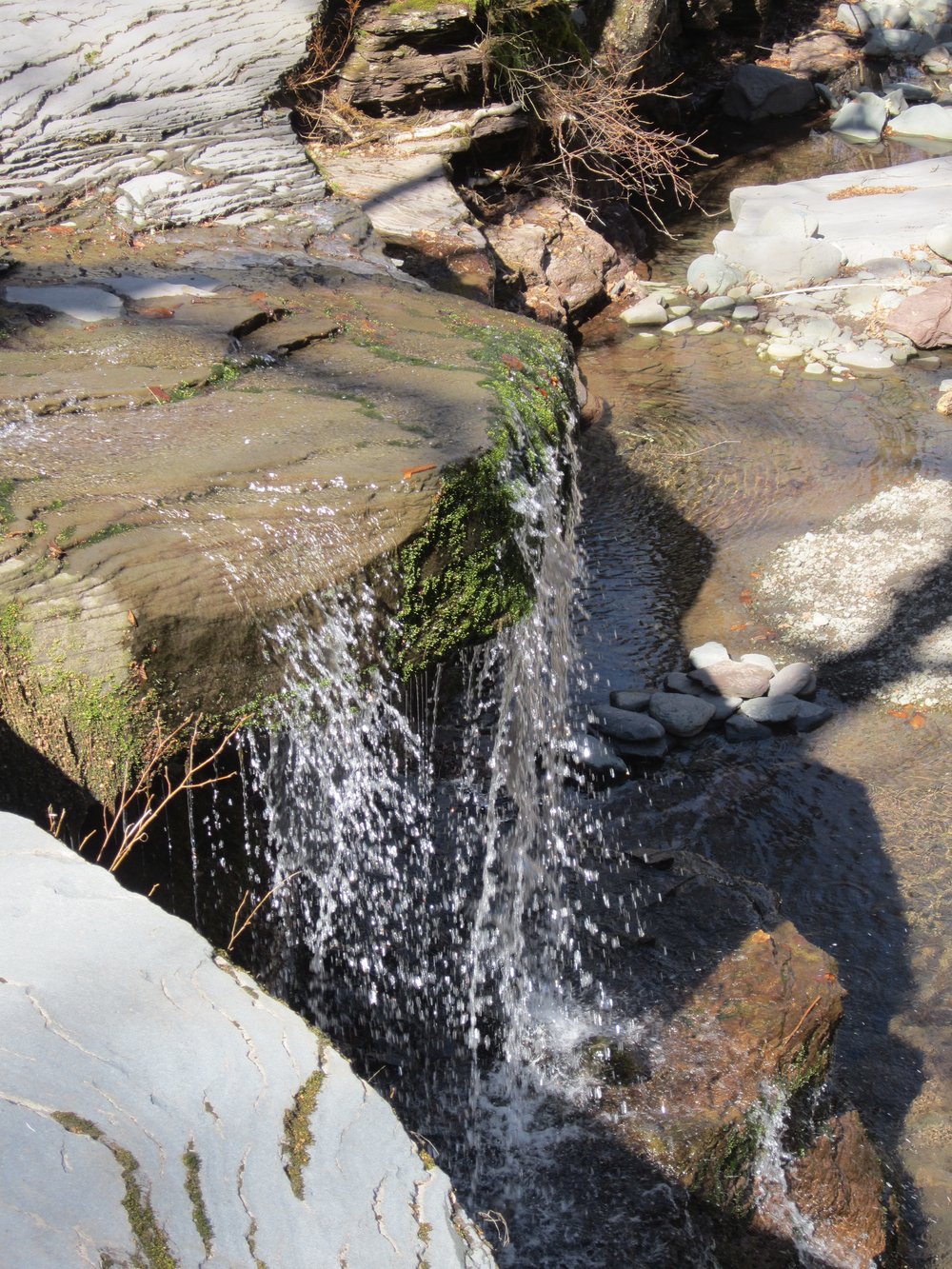
“Do you think you would be lonely living out here?” I ask our car full of women, all dressed for a day hike up West Kill peak. I used to romanticize living far from everyone and everything, craved silence the way some people crave chocolate. Mary responds quickly, “Yes.” I would be too, I admit. Though I often spend long days alone I always see another person: the post mistress, or Mikee the baker where I buy a brioche on Wednesday mornings. In the bakery I’ll know someone, share a few words, a laugh. I may only talk to another person for five minutes in a day but that is five minutes of touching the world. I think of these moments as ballast, keeping me upright. This Catskill town’s emptiness feels vast. To add to it, there is evidence, deep, piled up, destroyed evidence of Hurricane Irene from this past fall. Some bridges have been rebuilt, some remain in progress. But the river bed is wide, wider than is needed for the stream that now flows through. The debris that lines the riverbank includes massive logs and piles of brush. Looking at it I sense the force of the water that swept through here, altering this landscape.

“Do you think you would be lonely living out here?” I ask our car full of women, all dressed for a day hike up West Kill peak. I used to romanticize living far from everyone and everything, craved silence the way some people crave chocolate. Mary responds quickly, “Yes.” I would be too, I admit. Though I often spend long days alone I always see another person: the post mistress, or Mikee the baker where I buy a brioche on Wednesday mornings. In the bakery I’ll know someone, share a few words, a laugh. I may only talk to another person for five minutes in a day but that is five minutes of touching the world. I think of these moments as ballast, keeping me upright. This Catskill town’s emptiness feels vast. To add to it, there is evidence, deep, piled up, destroyed evidence of Hurricane Irene from this past fall. Some bridges have been rebuilt, some remain in progress. But the river bed is wide, wider than is needed for the stream that now flows through. The debris that lines the riverbank includes massive logs and piles of brush. Looking at it I sense the force of the water that swept through here, altering this landscape.
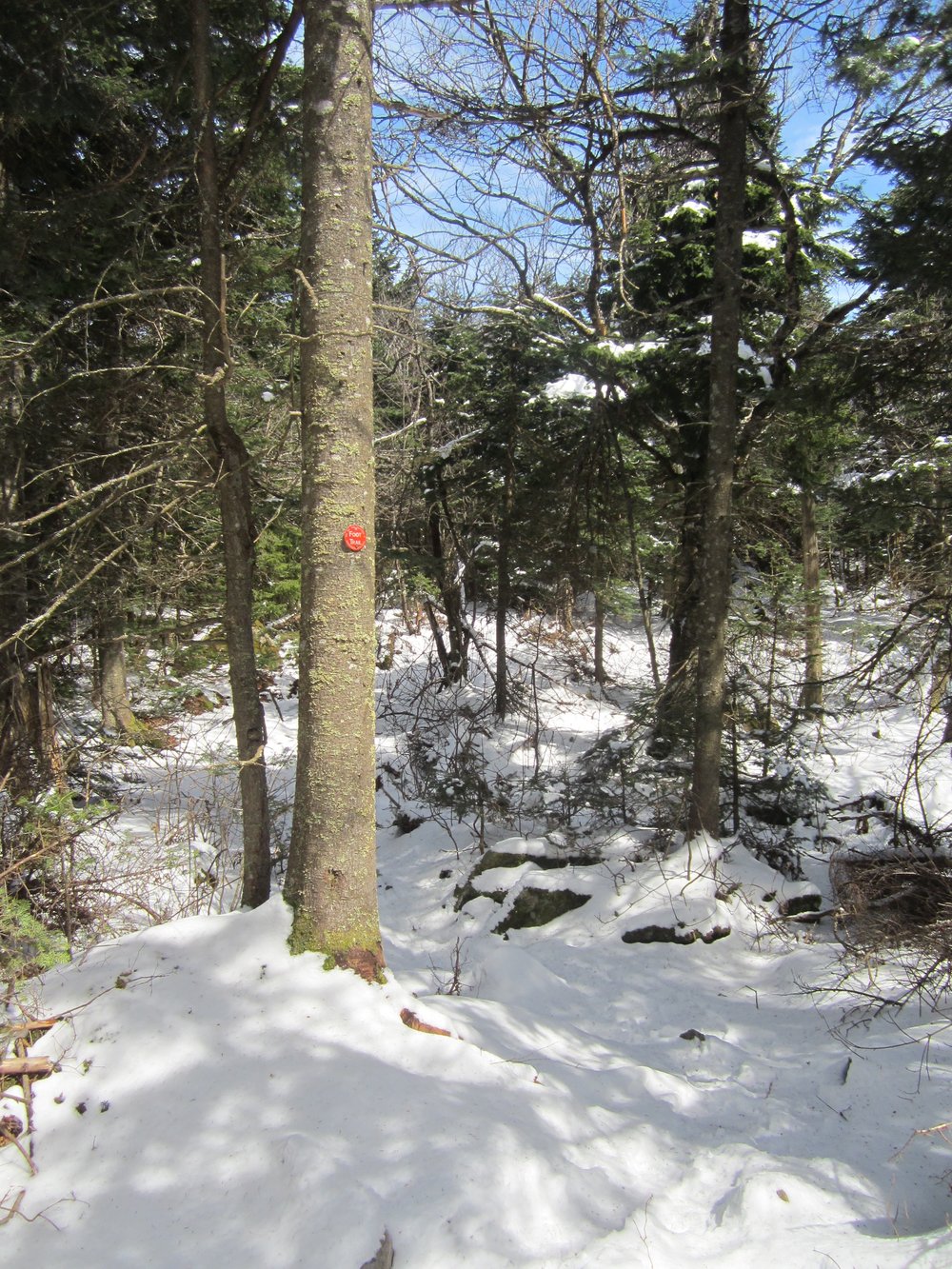
I am sure that I used to be a fun hiking companion to Mary and Connie, with whom I’ve shared many peaks. We would gab our way up and down mountains covering life’s most important topics: family, food and sex. Now, I have my binoculars strapped to my chest, eager to see what birds are living their lives on this snowy mountain. Rather than talk, I linger behind everyone looking for movement, or a small chip.
I am rewarded right away with a plump rusty Fox Sparrow. It’s one of my favorite sparrows and not just because we share a name. A Junco trills from the woods and further up the trail I hear a flock of Pine Siskin where they belong: in a pine tree.
Soon we are tromping through snow, and clambering over downed birch trees. We have had so little snow this winter that to walk through the soft layer pleases me.
A picnic on the summit offers one of the finest views from a Catskill Peak I have ever had. Often from these summits there is little or no view. In fact, you hardly know you’ve arrived at the summit. Here, we look into the valleys, the trees brown, but beginning to shade to green with new buds, the spread of the mountain range before us. We pick out other peaks: Plateau, there, Hunter, there, and share food.
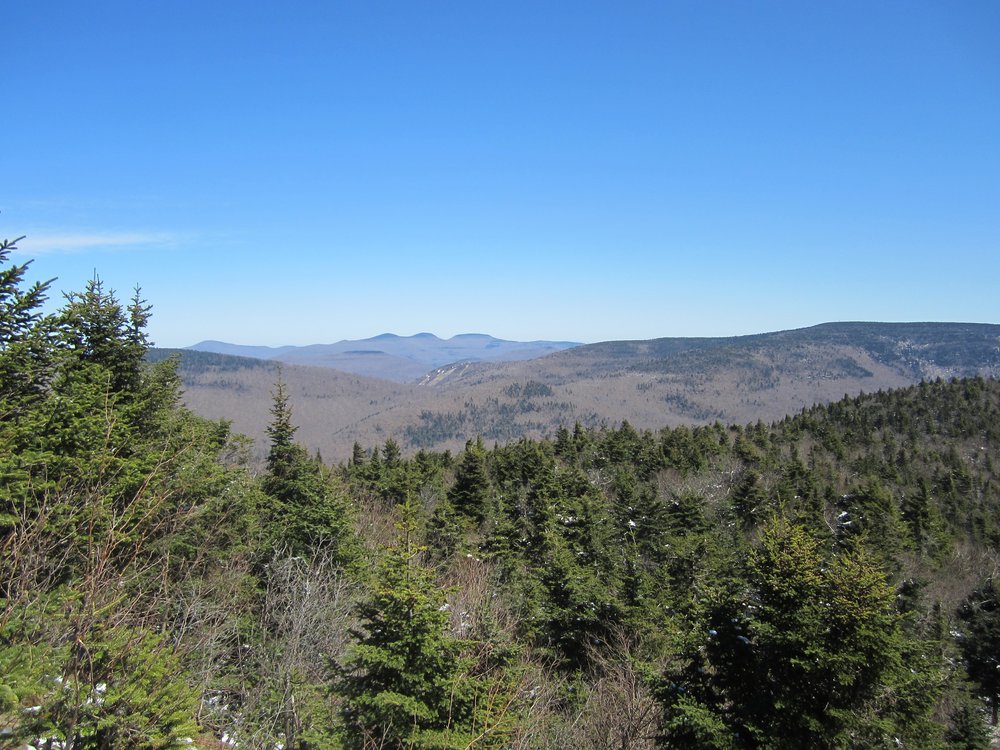
The quiet of the woods is my company on the descent. Too soon we are out of the snow and back at the stream, the falls. And there to greet us is a patch of Spring Beauties.
Flow On



The movement from rich to ordinary involved an influx of religious from Father Divine and his cult at Crum Elbow to the Ursline nuns in Beacon. When Carmer wrote, of the eight country seats, thirty-three were no long operated as estates and nineteen were medical education or religious institutions. “Thus in a strange way the people have won the river,” Carmer applauds.
Carmer writes about John R. Stuyvesant’s home, Edgewood, three miles north of Poughkeepsie that was sold to the Jesuits and was renamed St. Andrew’s-on-the-Hudson. This Jesuit monastery has become the Culinary Institute of America (known to locals as the CIA). Could he have imagined how these properties would flow on to the next generation?
A property in Saugerties, a town on the western short of the river just a bit north of Tivoli, has also flowed into the hands of anyone who wants to take a walk by the river. The northern end of the property belonged to Gilbert Spaulding, not one of the rich of the valley, but rather a veterinarian. He named the property Falling Waters, which remains to this day. The Dominican Sisters bought this property in 1931, as well as land where a former ice house operated, in 1932. And there the sisters had a summer vacation retreat. The sisters remain on the property, but they have opened up a portion of it for people to enjoy. Working with Scenic Hudson and the Esopus Creek Conservancy, the sisters have built a system of trails, with stunning views of the river. From time to time a bench invites walkers to sit by one of the two waterfalls. It is one of the few places along the river where you can walk in the woods and skip a stone on the Hudson River.
That is where Peter and I were headed on a drizzly Saturday morning. We had started our day at the Great Vly, a swamp just north of Saugerties, where we were delighted by Virginia Rail skulking its way through the reeds. Coots with their startling white bills hid among the reeds, and Tree Swallows, newly returned, swooped low over the water. Wood ducks took flight making their crying sound, while Horned and Pied-Billed Grebes floated on the placid water. Grebes are neat birds, with lobed toes that make walking on land difficult. So they mostly swim, float, and build floating nests (which I have never seen). The Pied-billed Grebe has a goofy thick bill that makes it one of the cutest birds on a pond.
We then drove to Falling Waters, cheered by our sightings. Had we stopped there, our day would have felt complete. But there’s a hunger that takes over after seeing a few good birds, all of these migrating through. Perhaps there were other treasures that had flown in through the night?
The trails at Falling Waters are gentle, winding through the woods, with strategic views onto the river, east to Magdalen Island, and north of that the Village of Tivoli. I always enjoy viewing my village from a different perspective, to see the crooked line of Friendship Street and the houses that open out to the water. But they are gazing across the railroad tracks. Here, no tracks ran nearby to jar our walk. We passed vinca in bloom and Bloodroot as well. Spring is here.

The day seemed complete, but we couldn’t help ourselves; if these birds were floating through what other migrants might also be in the area? It was my first day of spring break, and I had promised myself a rest from papers and grades. So there was no reason not to head back to the water’s edge.
Our good luck continued with more Bufflehead on the water, joined by Green-winged Teal and to Peter’s disbelief five Red-breasted Mergansers. We stood on the edge of the river, which was at low tide, to get a better look. Indeed, the birds did have dark chests and wispy crests, unlike the more rounded head of the Common Merganser.
It was dusk when we drove out of the parking lot, tired from gazing onto the gray waters of the river, the light shimmering through thick clouds.

“You don’t stop, do you?” Peter asked with a grin, turning toward the waterfront.
We pulled out the scopes, scanned the river.
“My god,” Peter said.
I peered into his scope. More Long-tailed ducks. I grinned.
We scanned some more.
“My god,” Peter said. He stepped away from the scope. “Just look.”
I looked, recognizing right away that we had some more Grebes. This time, Red-necked Grebes, a bird I had never seen before, bobbing in the fading light. Two neat birds with elegant flat heads, and red necks. They were making their way north, to breed somewhere in the Arctic.
Flow on. Flown on. Water, land and air: movement is inevitable. Land changes hands, birds fly north then south. Rivers are movement; this river carries birds and trash and once carried bricks and ice. Sometimes this flow is encouraging, sometimes unnerving, but always it is inevitable. To walk on some of the land of change, to see some of the flow in the fading light of a gray day makes me feel lucky. Flow on.

